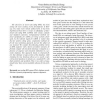Free Online Productivity Tools
i2Speak
i2Symbol
i2OCR
iTex2Img
iWeb2Print
iWeb2Shot
i2Type
iPdf2Split
iPdf2Merge
i2Bopomofo
i2Arabic
i2Style
i2Image
i2PDF
iLatex2Rtf
Sci2ools
CSB
2004
IEEE
2004
IEEE
FastR: Fast Database Search Tool for Non-Coding RNA
The discovery of novel non-coding RNAs has been among the most exciting recent developments in Biology. Yet, many more remain undiscovered. It has been hypothesized that there is in fact an abundance of functional non-coding RNA (ncRNA) with various catalytic and regulatory functions. Computational methods tailored specifically for ncRNA are being actively developed. As the inherent signal for ncRNA is weaker than that for protein coding genes, comparative methods offer the most promising approach, and are the subject of our research. We consider the following problem: Given an RNA sequence with a known secondary structure, efficiently compute all structural homologs (computed as a function of sequence and structural similarity) in a genomic database. Our approach, based on structural filters that eliminate a large portion of the database, while retaining the true homologs allows us to search a typical bacterial database in minutes on a standard PC, with high sensitivity and specifici...
| Added | 20 Aug 2010 |
| Updated | 20 Aug 2010 |
| Type | Conference |
| Year | 2004 |
| Where | CSB |
| Authors | Vineet Bafna, Shaojie Zhang |
Comments (0)

